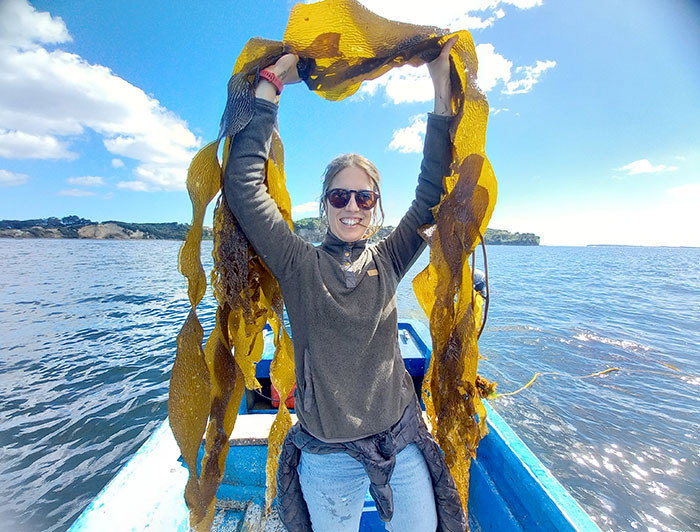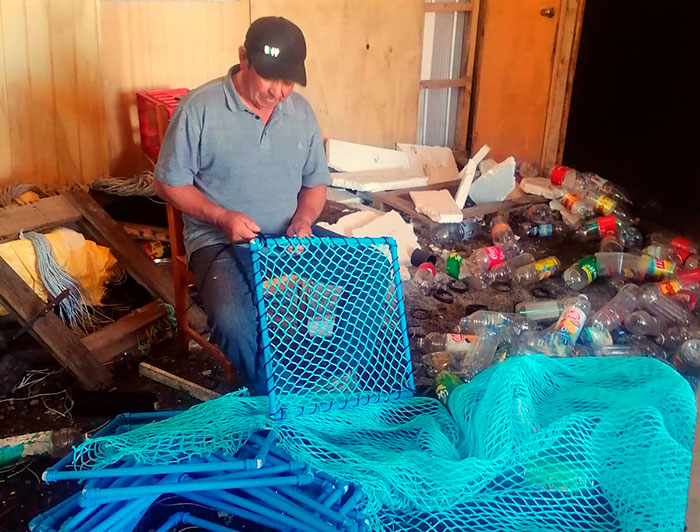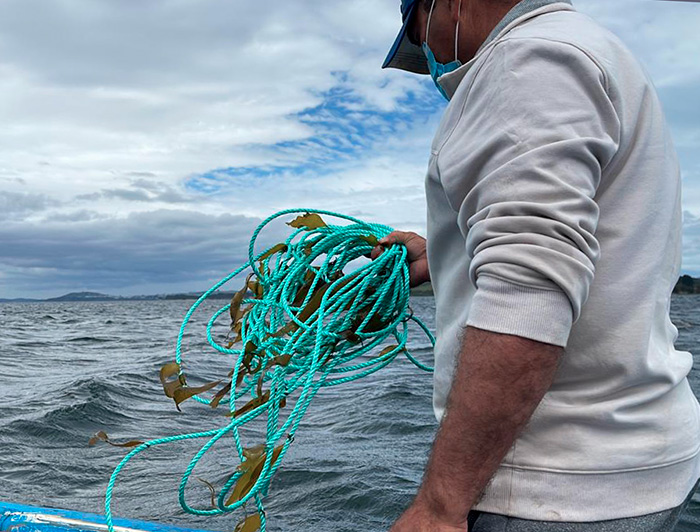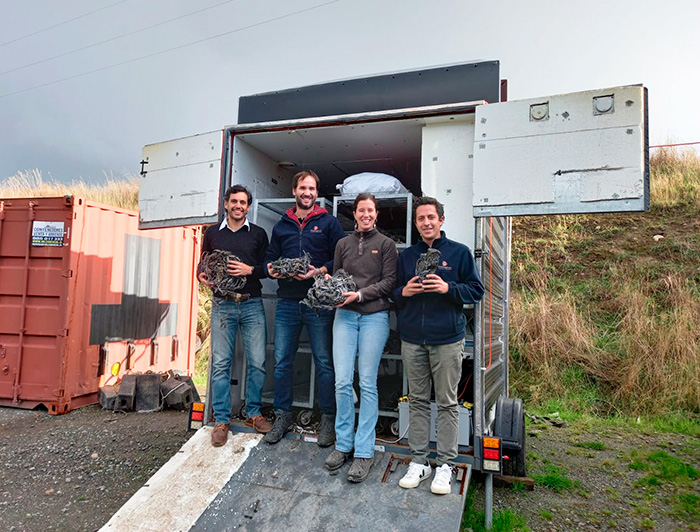
Huiro Regenerativo: Growing Seaweed for Sustainable Development
The startup, created by UC Chile biologist María José de la Fuente and Colab UC Chile executive director Sebastián Gatica, is revolutionizing the way communities and industry look at and relate to seaweed.

photo_camera The economic, social and environmental regeneration of marine territories is at the center of this startup that seeks to change the relationship between seaweed, communities and industry. (Photo: María José de la Fuente/Huiro Regenerativo)
Seaweed could be the key to addressing the food and climate crises affecting our planet.
By farming just two percent of the ocean, we could feed a world population of 12 billion people, according to the United Nations.
Seaweed is extremely rich in protein, vitamins, zinc and iron, and low in fat and carbohydrates.
It also:
- Removes large quantities of greenhouse gases from the atmosphere.
- Plays a key role in the fight against ocean pollution by cleaning the water of nitrates and phosphates.
- Can increase fish stocks by up to 20%.
Algae can be used as a natural fertilizer, as compounds in medicine and cosmetics, and as ingredients in a wide range of foods.
In addition, they have the potential to create thousands of jobs, thus creating sustainable development.
So why don't we grow them?
That is the very question that María José de la Fuente, a biologist from UC Chile, and Sebastián Gatica, executive director of the social innovation laboratory CoLab UC Chile, who created Huiro Regenerativo in February 2021, asked themselves.
As María José explained, “While we were observing the fishing communities, we realized that their extraction models were quite destructive and unsustainable.”
Under the current model, all seaweed is extracted from one place, according to the needs of the harvesters and the market. Once they are depleted, they move to the next area. It is never farmed.
“The company seeks the economic, social and environmental regeneration of marine territories. We have created a model of collaboration and synergy between the different stakeholders, which can also benefit the ecosystem.”
A Holistic Model: Territory, Community, Industry and Customers

Thus, a win-win idea was born.
One part is the development of a model with the aquaculture industry and the communities. The industry provides its concessions and infrastructure, to be used by Huiro Regenerativo together with surrounding communities, to develop collaborative seaweed farming there.
At the same time, the aim is for communities to advance seaweed farming in their own management areas. Knowledge and technologies are also delivered to jointly develop the sustainability of the model in the territory in the long term.
Through a training process for artisanal fishers, Indigenous peoples and coastal communities in general, the different processes for seaweed farming are taught, also taking advantage of their own local knowledge.
“We are inviting everyone from the community who is interested in the development of seaweed farming to participate” In the future, we want to connect with nearby high schools in order to foster youth becoming more involved in this type of model," said María José de la Fuente.
Furthermore, she added that the idea is to “set up collaborative farming, to empower communities and to accompany them with a governance model.”
On the industry side, salmon companies are interested in starting to develop a way to certify carbon sequestration and move towards carbon neutrality.
The industry has realized that being in a territory means that there are synergies to be made with local communities. These are driven by the corporate social responsibility areas.
Huiro Regenerativo also contacts customers, both national and international, to sell the seaweed, closing the cycle.
In other words, it is a win-win model for everyone, including the planet.
This is consistent with the discussion that has taken place in our country within the framework of the constitutional debate where the environmental, ecological and sustainability approach has gained relevance.
In particular, the concept of “restoration concessions,” where land, sea or forest leased for an activity, and then returned equal to or better than its original state.
In other words, the idea is to develop a friendlier relationship with the territories.
As Sebastián Gatica stated, “What we are looking for is to change the lenses through which people look at their sea, their coast. We want them to see it as a space that needs to be protected, but that it also provides opportunities, not only for extractive purposes. The idea is to change their perspective. How can we regenerate, repopulate these territories. And that this translates into well-being and improvement in economic terms.”
Seaweed Farming

Each seaweed has its own different farming process. However, not all seaweed can be cultivated.
The most studied crop is Macrocystis pyrifera, better known as huiro, sargassum or simply giant kelp. With heights that can exceed 70 meters (230 feet), they are large kelp that are distributed along almost the entire Pacific Ocean coast of the American continent and in most of the sub-Antarctic islands, forming true underwater forests.
The ecological system they form is a source of food, reproduction and refuge for hundreds of marine species that cohabit these “forests.”
To farm seaweed, seedlings are grown in artificial seedbeds and then attached to long-lines. These seeds have been inoculated with spores from natural banks in the area, in order to always maintain the genetic diversity of the populations.
When the seedlings reach two to three centimeters, they are transferred to the cultivation systems in the sea, where after three to four months they increase their biomass by 600%.
Another cultivable seaweed is pelillo, especially on the island of Chiloé. It is part of the Chiloé culture, where it has a long cultivation tradition.
“We have been gathering this knowledge from the communities, who are perfecting their systems and using new materials. We have tried to teach the communities to teach each other,” explained María José de la Fuente.
“We are farming and teaching the community the different cultivation systems. First, we prototype with them to see which seaweed grows best, because not all kelp grows everywhere.”
"They tell us which algae have grown there before and which have not. We perform tests, active training, we leave them all the knowledge, protocols and infrastructure, so that they can later grow a larger crop and have all the knowledge."
Blue Carbon
Blue carbon is the carbon captured by ocean ecosystems. Traditionally, terrestrial forests have been the main carbon sinks, but recent research has found that the oceans can be even more efficient at absorbing carbon from the atmosphere.
Hence, the emergence of an incipient industry of “blue carbon” bonds: financial instruments linked to carbon sequestration through the oceans.
Several institutions are working on it, such as the Environmental Defense Fund (EDF), Verra and GreenWave.
“It is something quite new still, but we want to put together certifications with the organizations we're working with. This is extremely important for the salmon industry,” explained María José.
Innovation and Sustainability

The next step of this startup is to generate innovative products.
Currently, the seaweed produced is sold to companies that produce bioplastics, bio-stimulants and pet food, among others.
According to Sebastián Gatica:
“We have to add value to it, so that the seaweed has a positive impact by making visible all the contributions it makes. We need to see how we can add innovation: generate industries that are novel, which add value, and that in turn contribute to sustainability and circularity.”
Hence, an important objective for Huiro Regenerativo is to create technologies and new products, and to open new markets.
“We want to target the more global food industry, with seaweed as food components: yogurts, jellies... there are thousands of products that have kelp components,” said Sebastián.
They also want to move towards other forms of farming.
“In the future we would like to make multi-trophic cultures, that is, of different species, combining algae, bivalves and mollusks. This is what comes naturally when you look at ecosystems, and it is a more sustainable farming model,” explained María José.
“For example, mussel crops are really harmful to the ecosystem, but by combining them with other species, they start to recycle more nutrients and, therefore, its harmful effects are reduced. The idea is to restore the ecosystem and simulate the natural state of nature."
But probably the biggest challenge is “…changing the paradigms of all the people involved,” said Sebastián.
“People who harvest are used to extracting as much seaweed as they can, and consumers are used to buying at exceptionally low prices. In general, seaweed is very poorly priced. So we have to change that. But it also requires a territorial strategy that involves the municipalities, private stakeholders and the generation of a public policy.”
“For this to work, we need a medium- to long-term perspective, where we really see it as an agent of development for the territories."
"We want to build a regenerative model, and we have consumers who understand that, but we are educating the entire chain."


